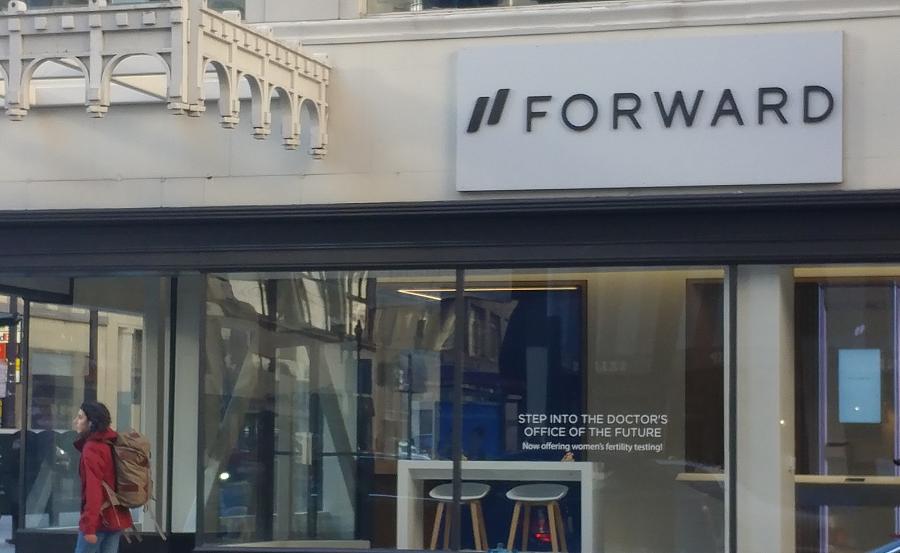Could a freshly designed patient experience revolutionize the doctor’s visit?

The future of the doctor’s visit is the topic of innumerable conference lectures, policy forecasts, and venture capital meetings. Will we all go to community clinics under single-payer health care? Will doctors’ offices shut down as on-demand house calls prosper? Will IBM Watson figure out what that pink mole is?
Forward, a new medical clinic in San Francisco, aims to answer that question differently. I visited Forward’s offices to get a sense of what a freshly-designed patient experience might feel like.
Early this year, Forward, founded by Adrian Aoun, former director of special projects for Google, made a splash in on tech blogs. “Doctors just need better tools, that put all the information they need in one place and then build an algorithm on top of it,” Aoun told Quartz. Forget the co-pays and crowded waiting rooms and in-n-out rushed service (indeed, many patients have had medical visits that lasted less time than the actual In-n-Out Burger ordering process). Instead, pay $149 per month—not covered by insurance but reimbursable by health savings accounts — have access to the latest technology, and leave calmer and in better health.
A receptionist greeted me in the plumly-located and sleek Forward office. The lobby area featured soothing blues, blond wood, and white decor; somewhat like what one would expect if invited to meet Sheryl Sandberg at Facebook. A display case featured an array of wearables (highly encouraged for patients), high-end skin products, and vitamins and supplements custom-blended for Forward.
I checked out the tablets embedded along the wall, which facilitate check-in and help the staff track patient flow through the building. The patient’s agenda for the day is a “playlist” — vitals, doctor visit, labs, and so on. In the lobby, I stood in a white body scanner of sorts that used infrared technology to reveal my height, weight, temperature, pulse and blood pressure, just from placing a couple of fingers on a sensor and standing on a platform while the beam scanned my body. Here, I got a little envious; it takes a lot of money to custom-design your very own body scanner. Aoun and company have that money, thanks to a corps of venture capitalists, like Vinod Khosla, who see Forward as a nascent national juggernaut and not just a concept clinic near the San Francisco Nordstrom.
An initial visit at Forward lasts an hour. According to the receptionist, the doctor goes through the patient’s medical history meticulously, in order to create a plan of action. At each visit, the patient can get labs drawn on site. Chemistry panels and complete blood counts, for example, are done “stat,” or with a minutes-to-hours turnaround, so the doctor can go over them in real time during the same visit. A custom mobile app holds all those results, so patients don’t have to remember what their potassium level was when they were taking that other blood pressure medication.
The exam room was a bit bigger than average. I settled into a comfortable, dentist-esque exam chair (yes, it had pelvic exam stirrups). The gigantic video screen—think baseball stadium Kiss Cam—displayed sample patient lab results at the touch of a button. This was my favorite part of the office. I liked that a doctor could touch the screen and go to an organ system and pull up relevant past history and results. Ephemeral information can be easily captured here, like the dose of antidepressant that caused problems. This is the kind of important nuance to medical care that is sometimes really hard to capture well in electronic medical records. In my own medical work, even when I saw patients with paper charts, I designed a form to capture tidbits about their care that I needed to remember at a glance.
A nearby tray held some of the fancy instruments hand-picked for Forward —a vein scanner that uses near-infrared light to create a blue-light “map” of arm veins (no more hunting and stabbing by the phlebotomist) and an advanced stethoscope.
I asked the receptionist whether a scribe joined the physician in the room for a Forward visit. Scribes, or computer notetakers trained in medicalese, are a huge boon to doctors, who can see more patients as a result and save their cognition for non-secretarial tasks. As it turns out, there is a scribe—who listens to the visit via a room microphone. It made sense, as exam rooms can get uncomfortable and hot with multiple people, and sensitive physical exams should be conducted with minimal personnel. After the visit, the doctor can review the notes to make sure everything was transcribed correctly.
I think of Forward as conceptual, but both meaningfully and aggressively so, in that its existence should make large health systems squirm. We have had access to technology that can do a quick body scan or visualize medical information nicely for a long time. Large HMOs, university systems, and even private clinics have not been nimble in this area, distracted as they are by bad software and adapting to technology based on whether it brings in more Medicare dollars instead of whether it improves actual medical care. Because Forward’s price is not prohibitive for a large segment of city-dwellers, if patients jump ship from established practices, the old guard may have no choice but to modernize and respond to this new challenge.

